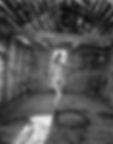Victoria, Alberta is an exhibition showcasing images made over an eight day period in South Western Alberta. Originally planned as a week of photography of a variety of models in the western landscape, plans quickly changed upon my arrival. After a hurried series of phone calls back to Halifax, a solution was found and Victoria, who’d worked with me in Nova Scotia, flew out to Alberta, to spend more than a week working with me in mountains, coulees, hoodoos and plains. The end result is one of the most focused bodies of work I have produced over the ten years since I began using a camera. Day after day I was challenged by the model and landscape to build upon the previous day’s work.
Drawn from images created over an eight-day period in Southern Alberta during the summer of 1999, Victoria. Alberta presents the ten images from the Victoria, the Alberta Portfolio along with an additional fifteen photographs selected specially for the exhibition. Where the images in the portfolio were selected by the portfolio patrons (without any context of the other images selected, or intent to have the images exhibited as a set), the additional photographs flesh out the project's results, and help tell a complete story of the first location-based body of work I produced.
This gallery only contains the additional fifteen images selected for the exhibition; the other ten photographs may be viewed on the Victoria, the Alberta Portfolio page.


The last day of the work with Victoria in Alberta was spent in the badlands on the east edge of the province; it was a hot, harsh environment to work in, but there was so much potential, I barely feel I scratched the surface of what could be created in the badlands. 4"x5" film

This is one of my favorite portrait of Victoria from the Alberta project. All through our visit to Alberta, I was seeking to make images that would really say “Alberta” (or rather, not Nova Scotia) when they were viewed, and I found few spaces as striking as Red Rock Canyon, in Waterton National Park. With steep, water-worn sides and a small, swift moving river at the bottom, it was the perfect setting for a dramatic portrait. 4"x5" film

The ripples in the sand under the water were just lovely, and Victoria‘s figure, crouched by the side provided the contrast to the dull tones of the riverside.

I can't think of many locations I have worked in as magical as Red Rock Coulee; as Victoria and I arrived shortly before sunset, we only had a short time to work, so much of what could have been created went unmade, but what we managed to record of film was really pleasing. 4"x5" film

I have always loved the wildness of Victoria's hair in this image. 4"x5" film


One of the strongest images of Victoria, this image was made during down time in Alberta, working indoors on the kitchen table. The skull had caught my eye from my first moment in Annie’s house, where I was staying, and from Victoria’s arrival, both of us agreed that we’d have to make an image with the skull. What amazed me was how still Victoria kept it during the second long exposure necessary in the poor light of the interior. 4"x5" film


When I was planning my work in Alberta, so much of my interest focused upon the mountains. As it turned out though, the first day working with Victoria was miles from the mountains - the only way to get them into an image at all was to use a long lens, and place Victoria on top of one of the Hoodoo’s and use the mountains as a backdrop.


When Victoria and I worked together in Alberta, a surprising number of the images were tight compositions, framing her body in the micro-landscapes we found throughout the landscape. That made photographs like this quite precious to me in retrospect, as it achieves a wonderful balance between Victoria’s body, and the landscape around her.

Made on a black cloth spread over the grass in the shade on the west-side of the house in which Victoria and I were staying in, the series of infrared skull images from Alberta are among my favourite “studio style” images I’ve ever made. The simplicity of the subject belies the incredible history that is contained in it; both in the symbolic reference of the mortality of the model, and in the historical referent to other artists who worked with skulls; O’Keefe being the central one.

All through Alberta, while working on the Victoria Portfolio, I sought to make portraits of Victoria, knowing that the majority of the images we’d been making were body oriented. This photograph was an impromptu portrait - I had loaned my dark cloth to Victoria so she could walk from one building to another without getting dressed, and she just lent against a doorway, and was waiting for me - and looked perfect. 35mm infrared film

The portfolio that was produced from the images made with Victoria in Alberta was my first focused body of work, and one of the first times I worked only with infrared film in my 35mm camera. This is one of the most lyrical images I made of Victoria in Alberta - there is something about the sea of white that surrounds her that is really lovely. 35mm infrared film

My first day working with Victoria in Alberta was amazing; I was so used to working with the granite rock formations around Halifax that the wind and water worn sandstone of South-West Alberta was like seeing in an entirely new way for the first time.
